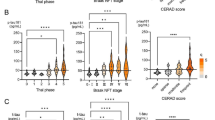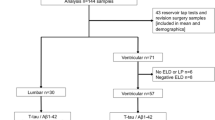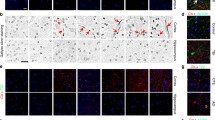Abstract
Objective
This study aims to determine if cerebrospinal fluid/serum cleaved tau protein and CSF 9-hydroxyoctadecadienoic acid levels, reflecting potential biomarkers of overall neuronal injury and lipid peroxidation, respectively, are elevated in brain tumor patients compared with controls.
Design
This article is a prospective clinical observational study.
Setting
This study is conducted at a tertiary-care children’s hospital.
Patients
Our participants are children younger than or equal to 18 years of age undergoing brain tumor surgery.
Measurements and main results
During the study period, 26 consecutive patients newly diagnosed with brain tumors who met the inclusion criteria were prospectively enrolled. Baseline cerebrospinal fluid analysis of cleaved tau and 9-hydroxyoctadecadienoic acid were measured in 15 patients. Cerebrospinal fluid cleaved tau and 9-hydroxyoctadecadienoic acid levels were measured in 22 patients for post-surgery days 1 and 3. Serum cleaved tau levels were measured for 20 and 18 patients for post-surgery days 1 and 3, respectively. The presence of a brain tumor significantly increased the baseline cerebrospinal fluid cleaved tau levels but did not affect cerebrospinal fluid 9-hydroxyoctadecadienoic acid levels. Similarly, there was a significant increase in post-surgery day 1 cerebrospinal fluid cleaved tau levels from baseline (p = 0.01) and a trend toward significant decrease in post-surgery day 3 cerebrospinal fluid cleaved tau from day 1 (p = 0.07). 9-Hydroxyoctadecadienoic acid concentrations remained relatively constant over time with no differences noted between the control and brain tumor patients. There was a trend towards a significant association between cerebrospinal fluid cleaved tau levels and duration of symptoms (p = 0.07).
Conclusions
Cerebrospinal fluid cleaved tau levels in children with newly diagnosed brain tumors exhibit markedly elevated cerebrospinal fluid cleaved tau levels, suggesting axonal damage. This axonal injury does not seem to correlate with lipid peroxidation at least when as assessed by cerebrospinal fluid 9-hydroxyoctadecadienoic acid levels. There was no association found between the biomarkers and multiple independent variables obtained at pre- and post-tumor resection.
Similar content being viewed by others
References
Gurney JG (1999) Topical topics: brain cancer incidence in children: time to look beyond the trends. Med Pediatr Oncol 33(2):110–112
Rosemberg S, Fujiwara D (2005) Epidemiology of pediatric tumors of the nervous system according to the WHO 2000 classification: a report of 1,195 cases from a single institution. Child’s Nerv Syst: ChNS: Off J Int Soc Pediatr Neurosurg 21(11):940–944
Bleyer WA (1999) Epidemiologic impact of children with brain tumors. Child’s Nerv Syst: ChNS: Off J Int Soc Pediatr Neurosurg 15(11–12):758–763
Grill J et al (2008) Childhood cerebral tumors: morbidity and follow-up into adulthood. Neuro-Chirurgie 54(5):623–641
Vinchon M et al (2011) Radiation-induced tumors in children irradiated for brain tumor: a longitudinal study. Child’s Nerv Syst: ChNS: Off J Int Soc Pediatr Neurosurg 27(3):445–453
Kochanek PM et al (2013) The potential for bio-mediators and biomarkers in pediatric traumatic brain injury and neurocritical care. Front Neurol 4:40
Fink EL et al (2014) Serum biomarkers of brain injury to classify outcome after pediatric cardiac arrest*. Crit Care Med 42(3):664–674
Kosik KS, Finch EA (1987) MAP2 and tau segregate into dendritic and axonal domains after the elaboration of morphologically distinct neurites: an immunocytochemical study of cultured rat cerebrum. J Neurosci Off J Soc Neurosci 7(10):3142–3153
Zemlan FP et al (1999) Quantification of axonal damage in traumatic brain injury: affinity purification and characterization of cerebrospinal fluid tau proteins. J Neurochem 72(2):741–750
Zemlan FP, Mulchahey JJ, Gudelsky GA (2003) Quantification and localization of kainic acid-induced neurotoxicity employing a new biomarker of cell death: cleaved microtubule-associated protein-tau (C-tau). Neuroscience 121(2):399–409
Irazuzta JE et al (2001) Serum cleaved tau protein and neurobehavioral battery of tests as markers of brain injury in experimental bacterial meningitis. Brain Res 913(1):95–105
Irazuzta JE et al (2000) Hypothermia as an adjunctive treatment for severe bacterial meningitis. Brain Res 881(1):88–97
Irazuzta JE et al (2002) Modulation of nuclear factor-kappaB activation and decreased markers of neurological injury associated with hypothermic therapy in experimental bacterial meningitis. Crit Care Med 30(11):2553–2559
Shaw GJ, Jauch EC, Zemlan FP (2002) Serum cleaved tau protein levels and clinical outcome in adult patients with closed head injury. Ann Emerg Med 39(3):254–257
Straiko MM et al (2006) Treatment with trimethyltin promotes the formation of cleaved tau in the rat brain. J Neurosci Res 84(5):1116–1123
Cengiz P et al (2008) Cerebrospinal fluid cleaved-tau protein and 9-hydroxyoctadecadienoic acid concentrations in pediatric patients with hydrocephalus. Pediatr Crit Care Med J Soc Crit Care Med World Fed Pediatr Intensive Crit Care Soc 9(5):524–529
Stoll LL, Morland MR, Spector AA (1994) 13-HODE increases intracellular calcium in vascular smooth muscle cells. Am J Physiol 266(4 Pt 1):C990–C996
Camacho M et al (1995) Interleukin-1 enhances the ability of cultured human umbilical vein endothelial cells to oxidize linoleic acid. J Biol Chem 270(29):17279–17286
Dandona P et al (2001) The suppressive effect of dietary restriction and weight loss in the obese on the generation of reactive oxygen species by leukocytes, lipid peroxidation, and protein carbonylation. J Clin Endocrinol Metab 86(1):355–362
Henricks PA et al (1991) 9- and 13-hydroxy-linoleic acid possess chemotactic activity for bovine and human polymorphonuclear leukocytes. Prostaglandins 41(1):21–27
Ku G et al (1992) Induction of interleukin 1 beta expression from human peripheral blood monocyte-derived macrophages by 9-hydroxyoctadecadienoic acid. J Biol Chem 267(20):14183–14188
Tontonoz P et al (1998) PPARgamma promotes monocyte/macrophage differentiation and uptake of oxidized LDL. Cell 93(2):241–252
Fischer B, von Knethen A, Brune B (2002) Dualism of oxidized lipoproteins in provoking and attenuating the oxidative burst in macrophages: role of peroxisome proliferator-activated receptor-gamma. J Immunol 168(6):2828–2834
Li WG et al (2003) Activation of NAD(P)H oxidase by lipid hydroperoxides: mechanism of oxidant-mediated smooth muscle cytotoxicity. Free Radic Biol Med 34(7):937–946
Inouye M, Mio T, Sumino K (1999) Formation of 9-hydroxy linoleic acid as a product of phospholipid peroxidation in diabetic erythrocyte membranes. Biochim Biophys Acta 1438(2):204–212
Metzger K et al (1995) Lipoxygenase products in human saliva: patients with oral cancer compared to controls. Free Radic Biol Med 18(2):185–194
Kreil P et al (1998) Strong increase of 9-hydroxy-10,12-octadecadienoic acid in low density lipoprotein after a hemorrhagic shock. Zeitschrift fur Naturforschung C, J Biosci 53(9–10):876–882
Cobbs CS et al (1995) Expression of nitric oxide synthase in human central nervous system tumors. Cancer Res 55(4):727–730
Spindler SA et al (1996) Significance and immunoassay of 9- and 13-hydroxyoctadecadienoic acids. Biochem Biophys Res Commun 218(1):187–191
de Bont JM et al (2008) Increased total-tau levels in cerebrospinal fluid of pediatric hydrocephalus and brain tumor patients. Eur J Paediatr Neurol 12(4):334–341
Trojanowski JQ et al (1989) Distribution of tau proteins in the normal human central and peripheral nervous system. J Histochem Cytochem 37(2):209–215
Sivanandam TM, Thakur MK (2012) Traumatic brain injury: a risk factor for Alzheimer’s disease. Neurosci Biobehav Rev 36(5):1376–1381
Tsitsopoulos PP, Marklund N (2013) Amyloid-beta peptides and tau protein as biomarkers in cerebrospinal and interstitial fluid following traumatic brain injury: a review of experimental and clinical studies. Front Neurol 4:79
Zemlan FP et al (2002) C-tau biomarker of neuronal damage in severe brain injured patients: association with elevated intracranial pressure and clinical outcome. Brain Res 947(1):131–139
Liu J et al (2014) Serum free fatty acid biomarkers of lung cancer. Chest 146(3):670–679
Reddy N et al (1997) Characterization of a 15-lipoxygenase in human breast carcinoma BT-20 cells: stimulation of 13-HODE formation by TGF alpha/EGF. Biochem Biophys Res Commun 231(1):111–116
Blask DE et al (2002) Light during darkness, melatonin suppression and cancer progression. Neuroendocrinol Lett 23(Suppl 2):52–56
Haas TA et al (1988) Binding of 13-HODE and 5-, 12- and 15-HETE to endothelial cells and subsequent platelet, neutrophil and tumor cell adhesion. Biochim Biophys Acta 961(2):153–159
Pasqualini ME et al (2003) Association between E-cadherin expression by human colon, bladder and breast cancer cells and the 13-HODE:15-HETE ratio. A possible role of their metastatic potential. Prostaglandins Leukot Essent Fat Acids 68(1):9–16
Svennerholm L (1968) Distribution and fatty acid composition of phosphoglycerides in normal human brain. J Lipid Res 9(5):570–579
Author information
Authors and Affiliations
Corresponding author
Rights and permissions
About this article
Cite this article
Cengiz, P., Zemlan, F., Eickhoff, J.C. et al. Increased cerebrospinal fluid cleaved tau protein (C-tau) levels suggest axonal damage in pediatric patients with brain tumors. Childs Nerv Syst 31, 1313–1319 (2015). https://doi.org/10.1007/s00381-015-2705-7
Received:
Accepted:
Published:
Issue Date:
DOI: https://doi.org/10.1007/s00381-015-2705-7




